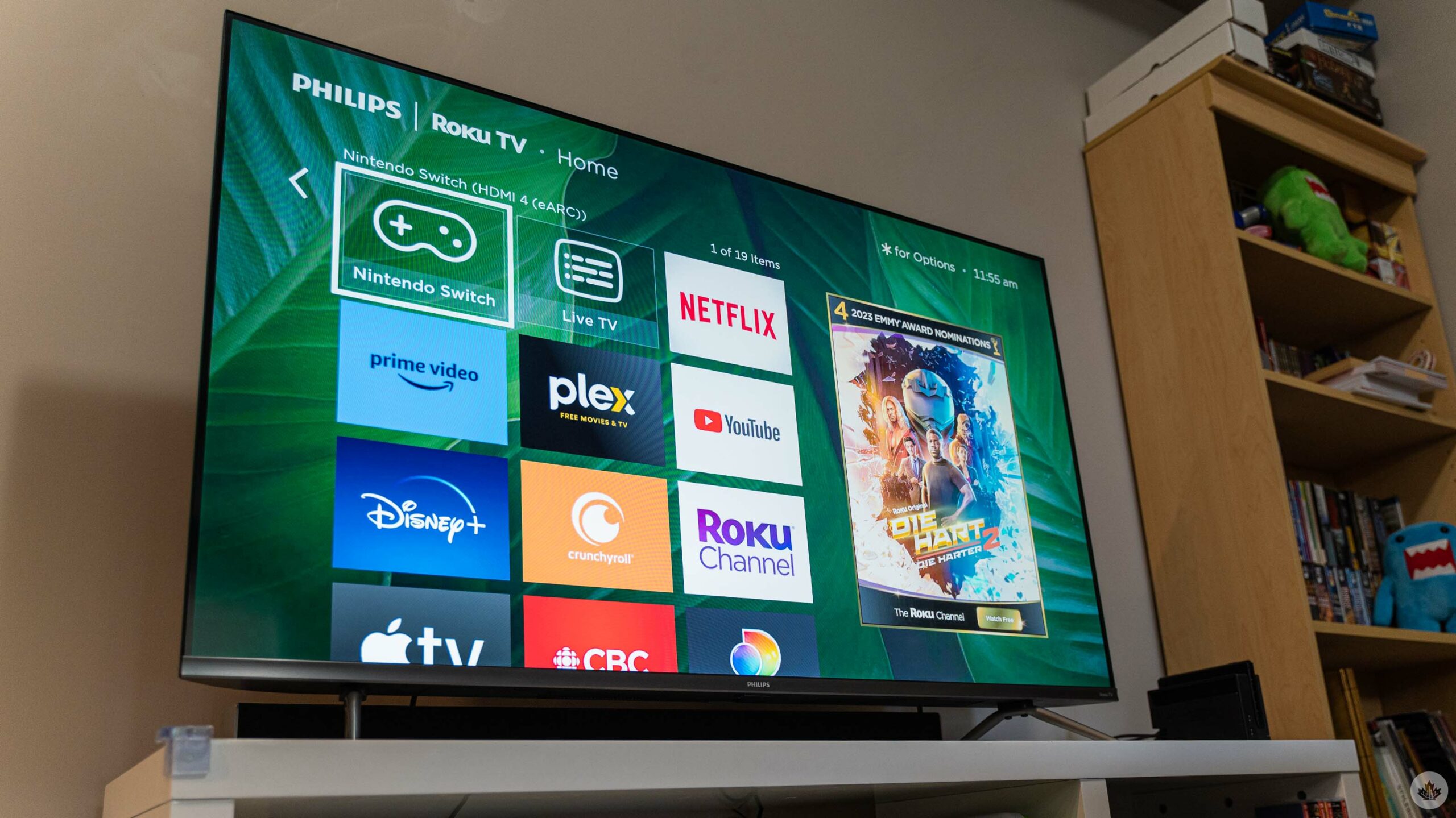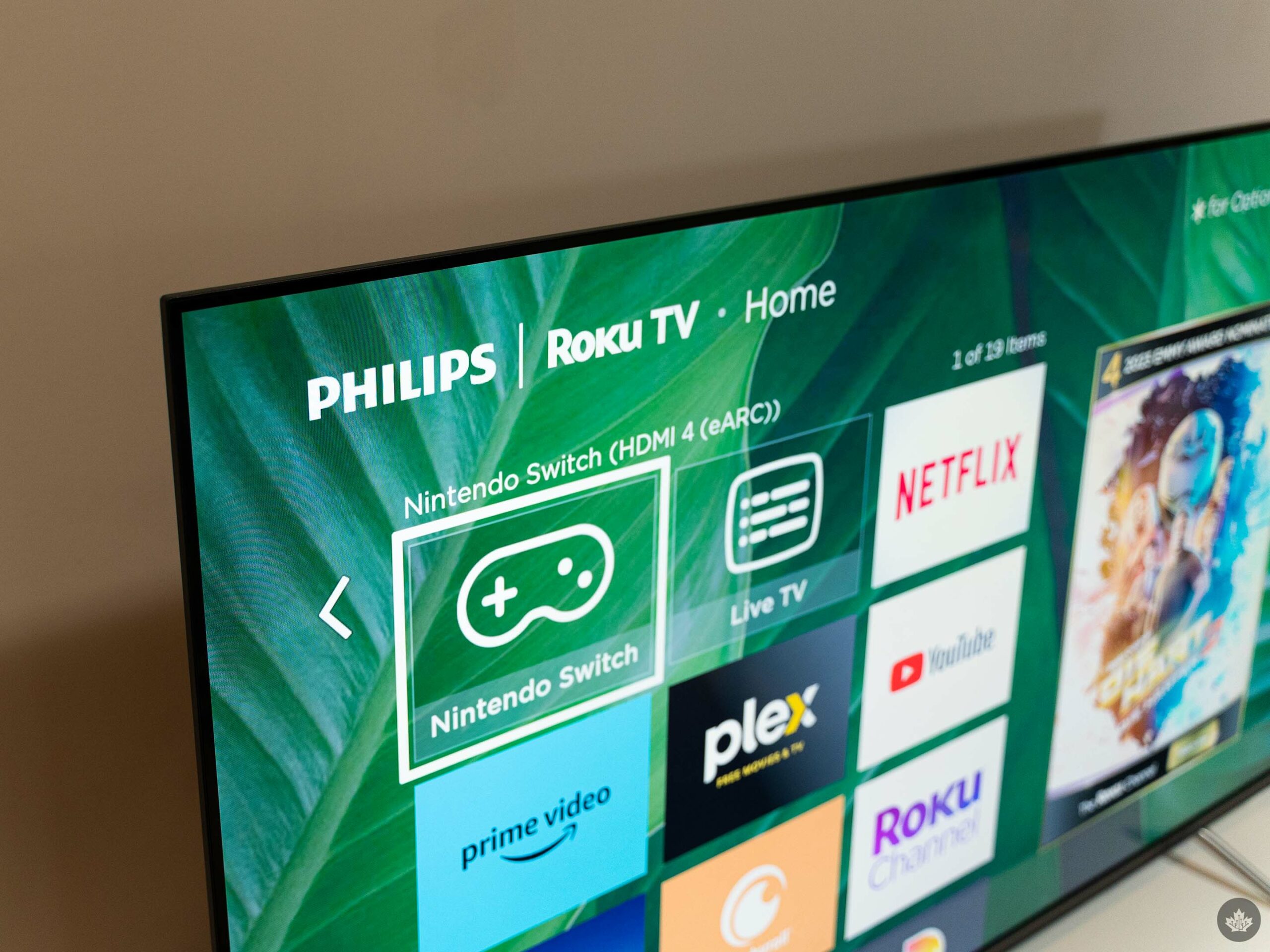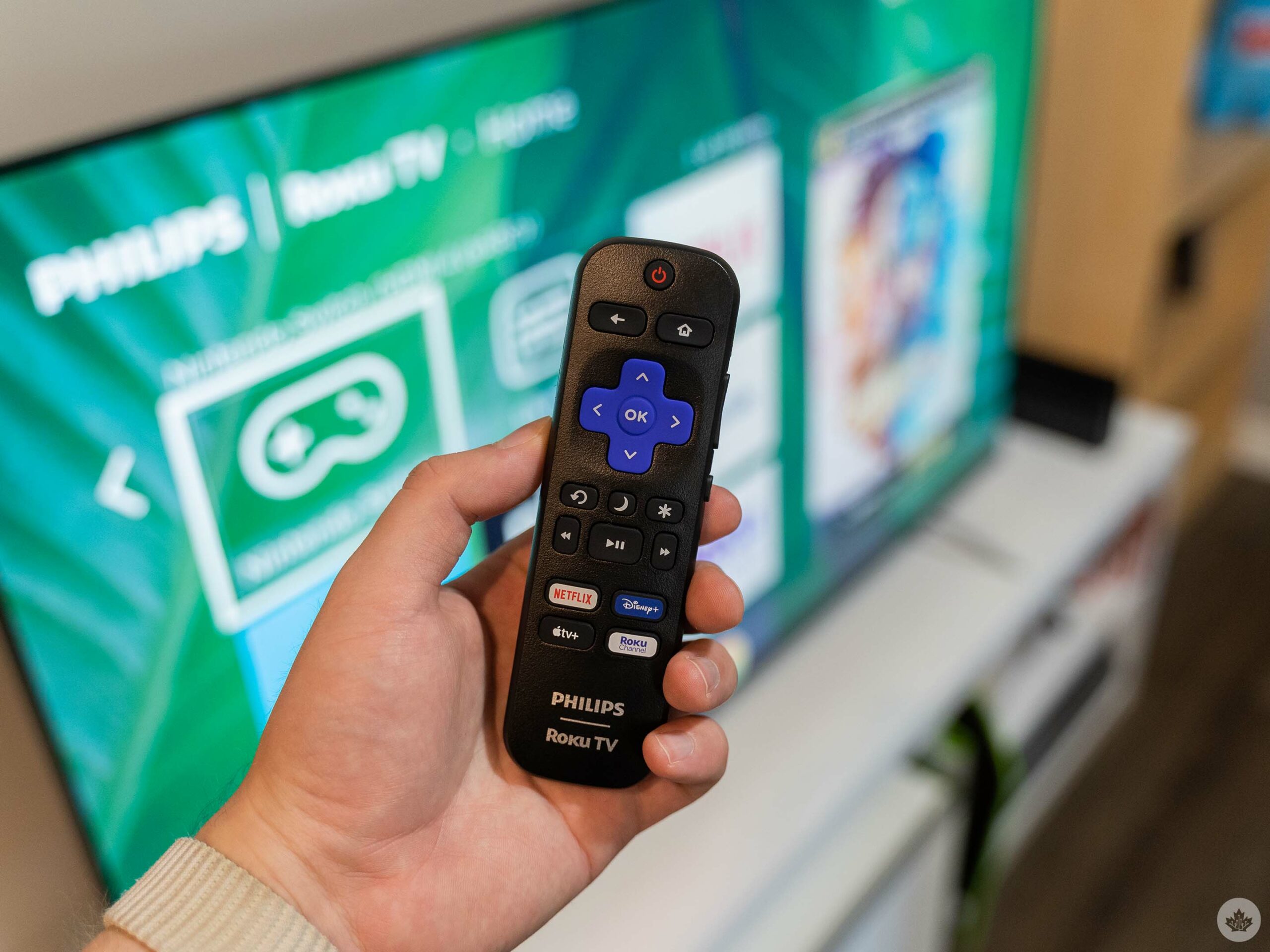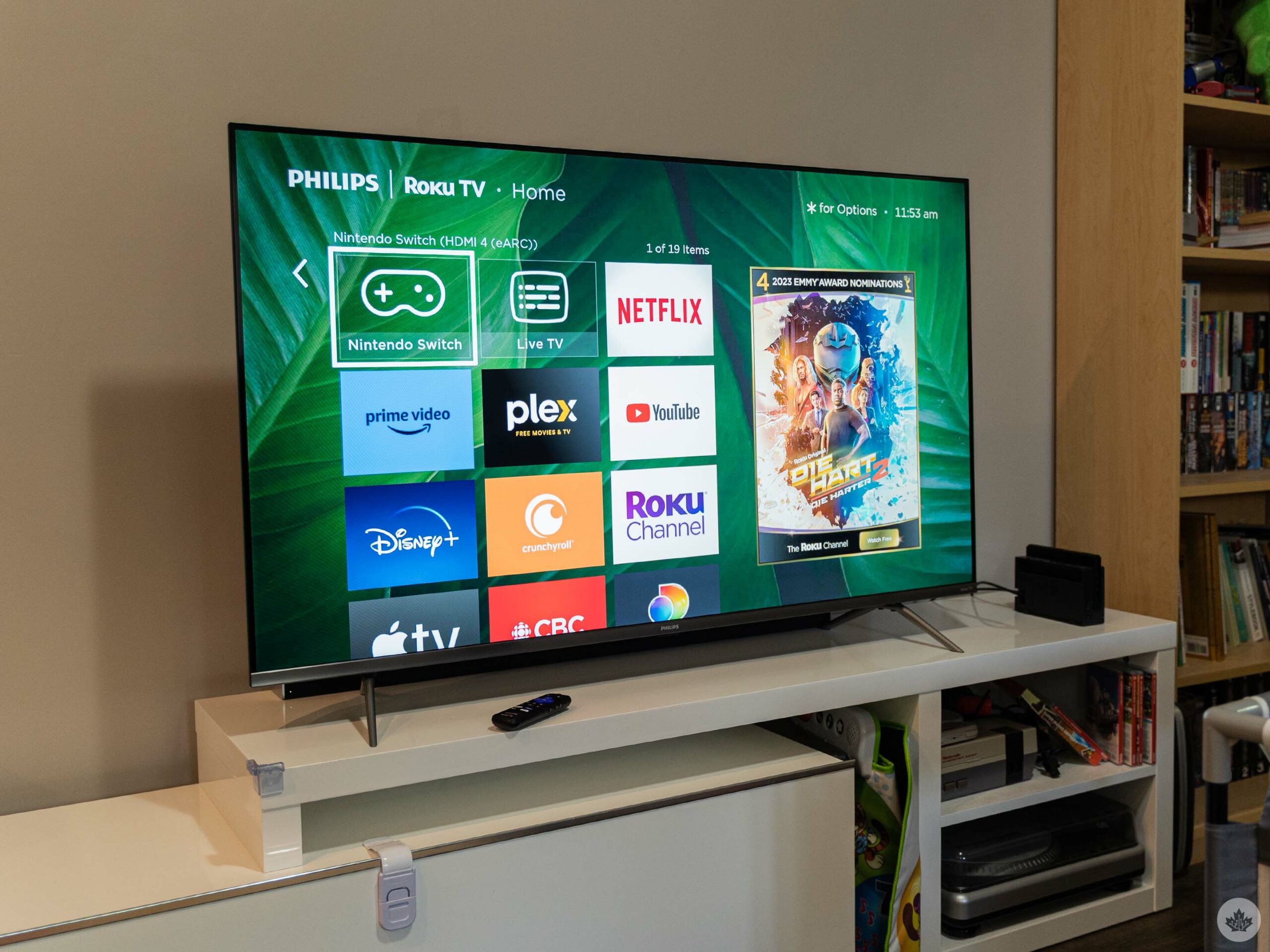
I am not much of a TV connoisseur.
There are all kinds of fancy TVs out there now, offering crazy high resolutions, HDR for a dazzling picture, higher refresh rates for gamers, and more. That’s great and all, but frankly, I don’t care about any of these things.
I use my TV to stream the occasional movie, show, or YouTube video. Sometimes I play a Nintendo Switch game with my wife, though she uses it far more than me. Because I do most of my gaming on PC, it doesn’t matter much to me what my TV can do as long as it accomplishes the basics: 4K with a decent picture.
For the last four years (if not more), I’ve used a TCL Roku smart TV. I don’t remember the specs beyond that it was 4K, LED and either 60- or 65-inches. It worked great, but I was quite excited when Roku offered to let me test out one of the new Philips 4K QLED Roku smart TVs announced last month. Part of it was I wanted to see how much better a QLED TV was compared to my current LED panel, and the other part of it was my TCL TV randomly developed a bizarre line across the middle of the display. It was about one pixel wide, and it bisected everything we watched, regardless of the source. The strangest part was that the line would sometimes show colours from toward the bottom of the screen as if the bottom row of pixels had been cut off and then slapped right in the middle of the TV.
Part of it was I wanted to see how much better a QLED TV was compared to my current LED panel, and the other part of it was my TCL TV randomly developed a bizarre line across the middle of the display. It was about one pixel wide, and it bisected everything we watched, regardless of the source. The strangest part was that the line would sometimes show colours from toward the bottom of the screen as if the bottom row of pixels had been cut off and then slapped right in the middle of the TV.
After a couple weeks with the Philips 4K QLED TV, I’m generally satisfied, though the biggest upgrade between the two was that the new Philips TV didn’t have that annoying line.
Specs
 Before I share more of my experience with the Philips TV, I want to go over the specs of my review unit quickly since there are a few different models. I tested the 55-inch version with model number ‘55PUL7973/F6.’ It’s part of the 7900 series, which includes 50-, 55-, 65-, and 75-inch options.
Before I share more of my experience with the Philips TV, I want to go over the specs of my review unit quickly since there are a few different models. I tested the 55-inch version with model number ‘55PUL7973/F6.’ It’s part of the 7900 series, which includes 50-, 55-, 65-, and 75-inch options.
Other specs include:
- 16:9 aspect ratio
- 5000:1 contrast ratio
- 6.5ms response time
- 178-degree viewing angle (horizontal and vertical)
- LCD UltraHD Display
- LED backlight
- 3840 x 2160p resolution
- Picture enhancement features include:
- Dynamic contrast
- 120 Perfect Motion Rate (PMR)
- HDR10
- HLG
For inputs, the TV has four HDMI ports, one of which has eARC support, CVBS+Audio L/R input, digital audio out (optical), ethernet, and headphone output. It supports 802.11ac Wi-Fi as well.
The 55-inch model I tested, as well as the other models, are available at Best Buy. The 55-inch model starts at $649.99. You can view all the specifications here.
A more refined experience
 With the specs out of the way, let’s dig into what it was like using the TV. Overall, I’d say it was a refined experience. Aside from that awful line on my old set, the biggest difference I noticed with the Philips QLED was navigating the Roku interface was much smoother. My old TCL TV used to be fairly snappy, but it’s gotten frustratingly slow recently (even before the dreaded line appeared). Unfortunately, I won’t be able to test the Philips TV’s longevity in this area as the review period was only a couple of weeks, but I suspect in time, it too will slow down significantly.
With the specs out of the way, let’s dig into what it was like using the TV. Overall, I’d say it was a refined experience. Aside from that awful line on my old set, the biggest difference I noticed with the Philips QLED was navigating the Roku interface was much smoother. My old TCL TV used to be fairly snappy, but it’s gotten frustratingly slow recently (even before the dreaded line appeared). Unfortunately, I won’t be able to test the Philips TV’s longevity in this area as the review period was only a couple of weeks, but I suspect in time, it too will slow down significantly.
As for the interface, if you’ve used any other Roku smart TVs or streaming devices, you’ll feel right at home here. For those who don’t have experience with Roku OS, it’s a fairly basic collection of square ‘channels’ that give you access to streaming services or anything you’ve plugged into the TV. There’s a wide selection of free TV streaming services too, such as Roku’s own channel, Tubi and others, as well as your typical Netflix, Disney+, Crave, Amazon Prime, Apple TV+ and other options.
The included remote also brought subtle but worthwhile enhancements. It has a slightly more square design, a matte finish that feels more premium than the glossy black plastic of previous remotes. Perhaps the best change overall was the four shortcut buttons – my old Roku remote had buttons for Netflix, CBS All Access, TuneIn and Deezer. In the four years I had the TV, the only one of those I used was Netflix. The new remote offers Netflix, Disney+, Apple TV+ and Roku Channel buttons, which is a lot better. Honestly, I’d love if at least one of the buttons was customizable.
PMR is unnoticeable at best and annoying at worst
 Most of my experience with the Philips QLED TV was positive, but there were a few annoyances too. First up, the attachable legs that come with the TV feel significantly less sturdy than those with the TCL TV. I think this is a factor of the Philips TV legs being slightly narrower for a more stylish look. This is a non-issue if you plan to mount your TV, however.
Most of my experience with the Philips QLED TV was positive, but there were a few annoyances too. First up, the attachable legs that come with the TV feel significantly less sturdy than those with the TCL TV. I think this is a factor of the Philips TV legs being slightly narrower for a more stylish look. This is a non-issue if you plan to mount your TV, however.
Speaking of the legs, through a combination of the Philips TV being slightly smaller and the legs being slightly closer together than on the TCL model, my soundbar couldn’t fit nicely between them like before. If soundbar placement is a concern, you’ve got a roughly 96cm gap between the legs at the front of the TV, narrowing to roughly 82cm at the real due to the angle of the legs. The legs lift the TV about 7cm, so if you’re soundbar is less than 7cm tall and about 80cm across, it should fit nicely beneath the Philips QLED.
 The TV’s inputs are also placed near the centre of the TV’s rear, which makes them a pain to reach without moving the TV. I’m fairly tall and have long arms to boot, but even I had trouble plugging things in without moving the TV around. I’d like to see future iterations bring the inputs out closer to the edge so they’re easy to reach.
The TV’s inputs are also placed near the centre of the TV’s rear, which makes them a pain to reach without moving the TV. I’m fairly tall and have long arms to boot, but even I had trouble plugging things in without moving the TV around. I’d like to see future iterations bring the inputs out closer to the edge so they’re easy to reach.
My main frustration with the Philips QLED, however, is the Perfect Motion Rate (PMR). PMR is Philips’ take on a fake 120Hz mode, even though the TV can only output at 60Hz. Through most of my testing, the PMR effect wasn’t all that noticeable, but occasionally it would make certain movie scenes look incredibly fake. I noticed it most in scenes with heavy CGI. Frustratingly, I couldn’t find any option to disable it in the TV’s settings, though it seems like there’s supposed to be an option.
Few complaints for $649.99

The ports are fairly recessed on the back of the TV, making them hard to reach.
Despite the relatively minor annoyances, the picture quality looks good enough for me and the TV does everything I need it to do. The Philips QLED is absolutely not the best TV out there, but looking at other 55-inch QLED options, it’ll be tough to beat on the value side. Most of the other 55-inch QLEDs shown on Best Buy’s website cost $800 and up. There was a 55-inch TCL QLED with Google TV listed for $549.99 that seems very comparable to the Philips QLED I tried. However, at the time of writing, the TCL one was sold out.
Those who don’t care for the QLED display can also opt for an LED panel instead and save a good chunk of change. After testing both types, I don’t notice enough of a difference to justify the QLED, but others might appreciate the brighter, more saturated colours.
The Philips 4K QLED Roku TV 2023 is available at Best Buy for $649.99.
MobileSyrup utilizes affiliate partnerships. These partnerships do not influence our editorial content, though MobileSyrup may earn a commission on purchases made via these links.
MobileSyrup may earn a commission from purchases made via our links, which helps fund the journalism we provide free on our website. These links do not influence our editorial content. Support us here.


